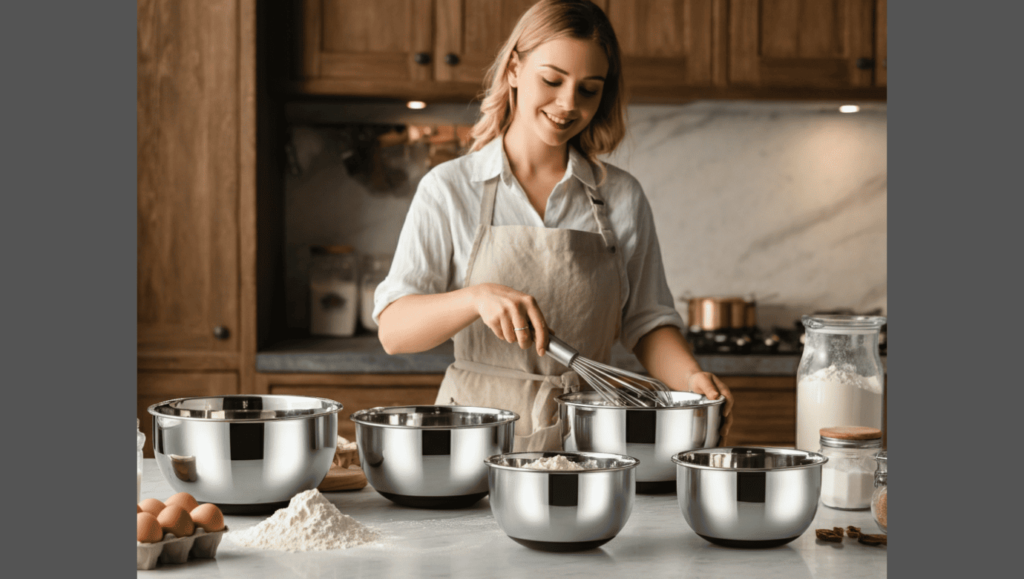
Baking enthusiasts say hello to the silicone baking mat that’s taking kitchens.
You can clean up quickly by taking your silicone baking mats to the sink while still hot. They are also easy to store in a cupboard or drawer. No electronics are ever required! Could you roll it up and put it away when not in use? After you read this, if you are still curious, how will these Japanese everyday goods that don’t exist in the lives of most Western consumers fit smoothly into mine?
What is a Silicone Baking Mat?
A silicone baking mat is a sheet for baking cookies, pastries, cakes, and other sweets. A silicone baking liner is a flat, flexible sheet made from food-grade silicone and melded to other materials, such as fiberglass, to give it durability. It is meant to fit into baking sheets and pans, obviating the need for parchment paper that is thrown away or greased.
These mats come in different styles and sizes to suit a variety of kitchen designs. No matter what, you bake cookies, roast vegetables, roll dough into a pie crust, or even make candy with a silicone baking mat, taking up some space somewhere on the counters- all your chores in the kitchen will be much easier.
Available Types and Sizes:
- Types: Plain mats, pre-lined mats with measurements, and mats with specific designs like circles for macarons.
- Sizes: Standard sizes for half-sheet and quarter-sheet pans, as well as custom options for specialty baking trays.
How Does a Silicone Baking Mat Work?
A silicone baking mat works by providing your baking tray with a non-stick, heat-resistant boundary between itself and the food.
NON-STICK PROPERTIES: Just as shiny and smooth as waxed paper, it will help your baked foods and roast dinners come easily off the pan without leaving anything stuck behind.
FREE REMOVAL OF RESIDUAL OIL – Loading all unnecessary pans creates extra work and costs time. It generates consistency by visiting patients with minor illnesses or at-home care families alike, saving them a huge amount of waste. With such profitable results, these are not everyday products. RECYCLED. Many miles of paper that were once so important but are no longer used end up in the trash. This isn’t good for the planet and costs time. It is impossible to clean off the surface with an impression in water resins of under 1 mm in thickness and difficulty.
Silicone baking mats work by creating a non-stick, heat-resistant barrier between your food and your baking tray.
- Non-Stick Properties: Just as shiny and smooth as waxed paper, it will help your baked foods and roast dinners come easily off the pan without leaving anything stuck behind.
- Heat Resistance: In terms of heat resistance, these mats are good for all the normal applications you normally wouldn’t associate with mats (from -40°F to 480°F [-40°C to 250°C]).
By eliminating the need for greasing or using disposable papers, these mats save time, reduce waste, and deliver consistently even baking results.
Benefits of Using a Silicone Baking Mat
Why should every kitchen have a silicone baking mat? Here are the key benefits:
- Eco-Friendly: Silicone baking mats eliminate the need for single-use parchment paper or aluminum foil, making them perfect for when you want to spend less time cleaning up while saving time and the environment.
- Cost-Effective: Although they have a higher upfront cost, they are an investment that saves money over time.
- Easy Cleaning: Simply wipe clean or rinse with soapy water for effortless maintenance.
- Even Baking: Distributes heat evenly, preventing burnt edges or undercooked centers.
Common Uses for a Silicone Baking Mat
Baking Cookies and Pastries
Thanks to the silicone baking mat, cookies will never stick to the tray, and pastries will never burn on the bottom. You’ll enjoy perfectly baked treats every time.
Kneading and Rolling Dough
So, whether you are making bread dough or rolling out pizza dough, the mat gives you a clean, non-stick surface for you to work and keep those messy flour spills in the sink.
Working with Sticky Materials
Not sticking to your work. The soft cut piece is an ideal surface for manipulating your sugars and candies (like fondant, marzipan, gum paste, taffy, caramel, toffees, chocolate, or fudge).
Roasting Vegetables and Meats
Silicone Baking Mat eliminates those itchy and scratchy sessions when so much oil is used that your side dishes no longer roast; rather, confit in a bath as the greaseless surface creates an even roast and browning of foods.
Tips for Using a Silicone Baking Mat Properly
- Before First Use: For first-time use, soak the silicone mat in warm water and rinse with warm, soapy water for at least 2 minutes.
- Avoid Sharp Objects: Never cut directly on the mat to avoid damaging it.
- Oven Placement: Place the mat inside the baking tray and off-center for the heat to circulate through the sides of the pan, not over it.
How to Clean and Store a Silicone Baking Mat
A silicone baking mat cleans up as easily as pie.
- Wash with warm, soapy water and a damp sponge.
- Tough spots? For stubborn stains, apply a paste made of baking soda and water to affected areas.
- Let air dry before rolling or storing to prevent the mat from losing its shape.
Which Is Better: Parchment Paper or Silicone Baking Mat?
While parchment paper is disposable and convenient for one-time use, silicone baking mats are a reusable, cost-effective alternative that’s ideal for frequent bakers. However, parchment paper may still win for tasks like lining cake pans or whenever cutting is involved.
Are Silicone Baking Mats Safe to Use in the Dishwasher?
Yes, many silicone baking mats are dishwasher-safe! However, hand-washing with mild soap often extends the life of the mat. If using a dishwasher, place it on the top rack to prevent warping.
Are Silicone Baking Mats Safe?
Absolutely. Food-grade silicone mats are made with non-toxic materials and are BPA-free. Their heat tolerance ensures they won’t release harmful chemicals during baking.
How Long Do Silicone Baking Mats Last?
With proper care, a high-quality silicone baking mat can last up to 3-5 years. Replace it when you notice cracks, discoloration, or loss of non-stick ability.
Best Silicone Baking Mats You Can Buy
When choosing a silicone baking mat, look for:
- Heat resistance up to 480°F (250°C)
- Non-toxic, BPA-free materials
- Reinforced fiberglass for durability
A few well-loved options include Silpat, Amazon Basics, and DANIA & DEAN. These mats offer superior non-stick coverage and are highly recommended by professional bakers.
The Reason You Should Have a Silicone Baking Mat in Your Kitchen

A silicone baking mat is a game for home bakers, professional chefs, and eco-conscious chefs. They’re durable, versatile, and an absolute blast to work with for a wide range of kitchen tasks.
Many baking mats of silicone also have measurement markings in inches and centimeters, making it easier to roll out the dough until it’s the right size, whether that’s for pizza, burgers, or donuts.
The baking mats of silicone are generally sticky throughout, so they do not move around on the tabletop. This prevents the mat from moving or slipping while it is being used. Whether you are rolling, cutting, or kneading dough, the mat never slips, and the back even has a nonslip texture to keep the mat right where you need it.
If you haven’t switched over yet, consider one for yourself. Not only will you experience easy baking and roasting, but you’ll also be kind to the planet.
Final Thought
And there you have it, the advantages of using a silicone baking mat as a home baker or master chef in a professional kitchen. Not only will you save money by not having to purchase parchment paper, but your baking will also improve. So why wait? Get yourself a set of silicone baking mats today, and see the difference now! Happy baking!
Please read our blog for more expert hacks and courses that will take your cooking to the next level. We appreciate you reading The Ultimate Guide to Silicone Baking Mats! Continue to cook with your heart and imagination!


